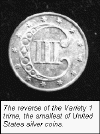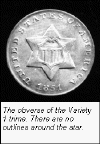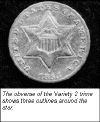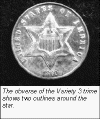|
| |
By Dennis Rocklein
(Editor's note: click on images to enlarge to full size.)
With the inflation that has occurred during the past few decades the
expression, “a ‘penny’ for your thoughts,” is not all that
appropriate. Not only do we not have ‘pennies,’ we have cents, but would have to
use 3 of them or 3 coins at a minimum to arrive at 3-cents.
It was not always necessary to use 3 coins, because there was a 3-cent
coin or unit issued by the United States Government. This article will present 3 different
types of 3-cent pieces of 6 different varieties issued by the U.S. Government that
actually circulated in this great country and which still to this day remain legal tender,
provided that anyone would want to spend one.
The Cause for 3-Cent Issuance
The 3 different 3-cent pieces were issued from 1851 to 1889, a period of
39 years. It started with a silver 3-cent piece that came about initially because in 1851
there was a great reduction in postal rates. In the 1840’s the postal system was
established with a rate of 5-cents for a 1/2 ounce letter for the first 300 miles,
10-cents for over 300 miles and on the Pacific coast 10-cents and 40-cents for the same
distances. In 1851, 1/2 ounce went 3000 miles for just 3-cents, and over 3000 miles for
6-cents. In fact the law of March 3, 1851 which changed the postal rates was the same law
that provided for the 3-cent piece. Why was the establishment of a silver 3-cent piece
necessary? Answer: to carry on government business. While it is true that 1-cent and 1/2
cent piece coins were made, they did not find great acceptance in the southern and western
states. In those areas coinage had to be of silver or gold. Copper was in disfavor, it did
not circulate. The government business carried on by the 3-cent piece was the sale of
postal stamps.
The 3-cent silver or trime
The 3-cent silver was first suggested in 1849. The first variety 3-cent
silver or trime issued 1851 to 1853, is probably the most simple in design of all United
States coins. The obverse holds a Union Shield on a 6-pointed star in the center with
“UNITED STATES OF AMERICA” around and the date below. The reverse has the plain
Roman numeral III (3) in a large “C” with 13, 6-pointed stars around.
The Variety 1 trime is the only United States coin to have been minted
with a composition of 750 parts silver and 250 parts copper. The trime was the first U. S. coin worth
considerably less than face value in metallic content. The actual metallic value was 86%
of face value, which sounds great considering our token coinage of today, but which at the
time limited the legal tender value to 30 cents. The variety 1 trime holds .6 gram of
silver. It was used to retire low denomination foreign coins and was the most plentiful
United States silver coin in circulation from 1851 to 1853, after which the other silver
coins were reduced in weight. It was the first U. S. coin issued without the word
“Liberty” or any symbolization of Liberty on it. It is the only U. S. Coin to
have 1 star dominant on one side of the coin. (Texas the lone star state was admitted to
the union in 1845.) The above facts are very interesting in view of the political
situation regarding the north and south and slavery in that time period. The trime of 1851
was the smallest denomination made at the New Orleans mint. All other 3-cent coins were
made at Philadelphia. silver and 250 parts copper. The trime was the first U. S. coin worth
considerably less than face value in metallic content. The actual metallic value was 86%
of face value, which sounds great considering our token coinage of today, but which at the
time limited the legal tender value to 30 cents. The variety 1 trime holds .6 gram of
silver. It was used to retire low denomination foreign coins and was the most plentiful
United States silver coin in circulation from 1851 to 1853, after which the other silver
coins were reduced in weight. It was the first U. S. coin issued without the word
“Liberty” or any symbolization of Liberty on it. It is the only U. S. Coin to
have 1 star dominant on one side of the coin. (Texas the lone star state was admitted to
the union in 1845.) The above facts are very interesting in view of the political
situation regarding the north and south and slavery in that time period. The trime of 1851
was the smallest denomination made at the New Orleans mint. All other 3-cent coins were
made at Philadelphia.
 The
second variety of trime, 1854 to 1858, is modified to effect that there are now 3 outlines
to the star. The reverse was modified so that there is an olive sprig over the III and a
bundle of arrows beneath. The greatest change of variety 2 is in weight and composition.
The weight was reduced to 3/4 gram, making it the smallest in weight and thickness of any
U.S. coin. The composition was changed to .900 silver with .100 copper, thus increasing
the silver weight .075 gram to .675 gram. The trime misses being the smallest U.S. coin in
diameter by 1 mm. The type 1 gold dollar (1849-1854) is 13 mm in diameter. The trime is 14
mm in diameter. Because of the changes in composition and design, the 2nd variety trime is
usually weakly struck having incomplete shield lines and dates even on uncirculated
specimens. The
second variety of trime, 1854 to 1858, is modified to effect that there are now 3 outlines
to the star. The reverse was modified so that there is an olive sprig over the III and a
bundle of arrows beneath. The greatest change of variety 2 is in weight and composition.
The weight was reduced to 3/4 gram, making it the smallest in weight and thickness of any
U.S. coin. The composition was changed to .900 silver with .100 copper, thus increasing
the silver weight .075 gram to .675 gram. The trime misses being the smallest U.S. coin in
diameter by 1 mm. The type 1 gold dollar (1849-1854) is 13 mm in diameter. The trime is 14
mm in diameter. Because of the changes in composition and design, the 2nd variety trime is
usually weakly struck having incomplete shield lines and dates even on uncirculated
specimens.
The third variety of trime 1859-1873, has the obverse modified so that there are 2 lines
bordering the star and the date is smaller. The reverse is the same as type 2. There are 3
overdates in variety 3, 1862/1, 1863/2 and 1869/8. Circulated coins 1863 and after are
rarely encountered. They were melted or exported. The mint practice at the time was that
one could bring silver and gold to the mint and have coins of the current year made to
order or received in exchange. Also to acquire proof coinage, coin was the only acceptable
medium of exchange. With the lack of coin in circulation due to the suspension of specie
payment in 1862, it is surprising that any later trimes exist at there are 2 lines
bordering the star and the date is smaller. The reverse is the same as type 2. There are 3
overdates in variety 3, 1862/1, 1863/2 and 1869/8. Circulated coins 1863 and after are
rarely encountered. They were melted or exported. The mint practice at the time was that
one could bring silver and gold to the mint and have coins of the current year made to
order or received in exchange. Also to acquire proof coinage, coin was the only acceptable
medium of exchange. With the lack of coin in circulation due to the suspension of specie
payment in 1862, it is surprising that any later trimes exist at  all, however existence
of the 1863 to 1873 trimes, primarily proofs, is probably due to the above 2 facts. The
trime was eliminated by the law of February 12, 1873, the crime of 1873, which also
eliminated the silver dollar. James B. Longacre designed the trimes which all have plain
edges.
all, however existence
of the 1863 to 1873 trimes, primarily proofs, is probably due to the above 2 facts. The
trime was eliminated by the law of February 12, 1873, the crime of 1873, which also
eliminated the silver dollar. James B. Longacre designed the trimes which all have plain
edges.
Change in Monetary Policy Affects the 3-Cent Issue
Prior to 1861, all U.S. government issues of money were specie or hard
money having metallic value at or near to face value. On July 17, 1861, legislation was
passed creating a federal status paper currency while suspending specie payments. The new
paper currency could not be redeemed in specie or coin, so as a result all gold and silver
coins disappeared from circulation, including the trime. Congress acted again on July 17,
1862, authorizing the issuance of postage stamps by the treasury to alleviate the small
change shortage. Unfortunately this idea was unsuccessful and short lived for stamps wore
out quickly and there was no provision for redemption or exchange of worn stamps. One
bright person, J. Gault, patented an August 12, 1862, a method of encasing postal stamps.
Although this was successfully accepted and advertising covered the cost of encasing the
stamps, the project was short lived for lack of sufficient postal stamps. Scoville
Manufacturing produced the encased postage. The most common denomination of encased
postage is 3-cents, probably due to the fact that 3-cent stamps were most common.
The 3-Cent Note

Front and back of 3 cent note
 The
3-cent note is from the third issue of fractional currency, which was authorized by act of
congress in the Treasury Bill Law of June 30, 1864. The act passed entire responsibility
of currency to the Secretary of the Treasury, Salmon P. Chase. He received authority of
denomination, design, method, and redemption. The first act of Secretary Chase was to
provide the 3-cent denomination. S. M. Clark superintendent of the National Currency
Board, had a great influence on design of the third issue notes. He actually placed his
picture on the 5-cent note. He worked with Dr. Stewart Gwynne, a chemist, on various
methods, including papers, inks and designs to thwart counterfeiting. The
3-cent note is from the third issue of fractional currency, which was authorized by act of
congress in the Treasury Bill Law of June 30, 1864. The act passed entire responsibility
of currency to the Secretary of the Treasury, Salmon P. Chase. He received authority of
denomination, design, method, and redemption. The first act of Secretary Chase was to
provide the 3-cent denomination. S. M. Clark superintendent of the National Currency
Board, had a great influence on design of the third issue notes. He actually placed his
picture on the 5-cent note. He worked with Dr. Stewart Gwynne, a chemist, on various
methods, including papers, inks and designs to thwart counterfeiting.
The obverse of the 3-cent note has as the centerpiece a portrait of
George Washington. There are 2 varieties of 3-cent notes, one has a light background and
one has a dark background to Washington’s portrait. Above George is “United
States” and “ACT OF MARCH 3D 1863” (the date of authorization for all
fractional currency.) To the sides are boldly “THREE…CENTS” and hard to
read “RECEIVABLE FOR…ALL U.S. STAMPS,” and “FURNISHED ONLY BY
THE…ASSISTANT TREASURERS,” “& DESIGNATED DEPOSITORIES…OF THE
UNITED STATES.” Below are “FRACTIONAL CURRENCY” and “TREASURY
DEPARTMENT” (where they were printed, which is today the Bureau of printing &
engraving.) A scroll with the words “E PLURIBUS UNUM” (one among many) is on the
shields in the upper corners the center of which is a “3”. The centerpiece of
the reverse is an ornate “3” surrounded by 16 stars. The legend reads (to left)
“This note is exchangeable for, UNITED STATES NOTES, BY ASSISTANT TREASURERS, AND
DESIGNATED DEPOSITARIES OF, THE UNITED STATES” and (to right) “in sums not less
that Three Dollars, RECEIVABLE IN PAYMENT, OF ALL DUES TO THE, UNITED STATES LESS THAN
FIVE DOLLARS, EXCEPT CUSTOMS.” In the 4 corners is the Roman numeral III in an
ellipse. The 3-cent notes were printed in sheets of 25 on thick or thin white bond paper.
They were printed damp then dried. The third issue of fractional currency was issued from
December 5, 1864, to August 16, 1869. However an act of congress on May 17, 1866,
prohibited the issue of any bill with a denomination of less than 10 cents.
The 3-Cent Nickel
An act of Congress on March 3, 1865, created the 3-cent nickel. It was
the result of lobbying by nickel interests. One company than contributed to the lobbying
of congress was the Scoville Manufacturing which provided nickel planchets to the mint in
the 1860’s. James B. Longacre designed the 3-cent nickel, which has a plain edge.
 The reverse and obverse of the nickel 3 cent The reverse and obverse of the nickel 3 cent
 The obverse of the 3-cent nickel portrays Liberty facing
left. In liberty’s hair is a “tiara,” a woman’s crown-like headdress
of jewels commonly called a coronet. The word “LIBERTY” is incuse on the
coronet. “UNITED STATES OF AMERICA” is around and the date is below the bust.
The reverse holds a laurel wreath, nearly identical to the laurel wreath on the 1859
Indian cent (also designed by Longacre), around the Roman numeral III. The nickel coinage
circulated despite the lack of specie payment because it was not a specie coin. The reason
for introduction of the 3-cent nickel was to retire the 3-cent notes. The low mintage
after 1873 is directly related to redemption of the 3-cent notes and silver 3-cent pieces.
The 3-cent nickel is exactly the same diameter as a dime, 17.9 mm, which caused it to be
confusing and unpopular. Nickel looks like silver, thus is readily acceptable, while
holding far less metallic value. Many of the coins show clash marks in the fields on one
or both sides of the coin. Nickel 3-cent pieces were often weekly struck or made from worn
dies. The word “Liberty” and Roman Numeral III are often weak or incomplete even
on uncirculated specimens. The only over-date nickel is the 1887/6 only available as a
proof. The nickel 3-cent was in production from 1865 to 1889, 25 years. All were made at
the Philadelphia mint. The final demise of the 3-cent nickel was assured by 2 events.
First, in 1875, specie payments were resumed. Second, in 1885, the postal rate was reduced
uniformly to 2-cents. The obverse of the 3-cent nickel portrays Liberty facing
left. In liberty’s hair is a “tiara,” a woman’s crown-like headdress
of jewels commonly called a coronet. The word “LIBERTY” is incuse on the
coronet. “UNITED STATES OF AMERICA” is around and the date is below the bust.
The reverse holds a laurel wreath, nearly identical to the laurel wreath on the 1859
Indian cent (also designed by Longacre), around the Roman numeral III. The nickel coinage
circulated despite the lack of specie payment because it was not a specie coin. The reason
for introduction of the 3-cent nickel was to retire the 3-cent notes. The low mintage
after 1873 is directly related to redemption of the 3-cent notes and silver 3-cent pieces.
The 3-cent nickel is exactly the same diameter as a dime, 17.9 mm, which caused it to be
confusing and unpopular. Nickel looks like silver, thus is readily acceptable, while
holding far less metallic value. Many of the coins show clash marks in the fields on one
or both sides of the coin. Nickel 3-cent pieces were often weekly struck or made from worn
dies. The word “Liberty” and Roman Numeral III are often weak or incomplete even
on uncirculated specimens. The only over-date nickel is the 1887/6 only available as a
proof. The nickel 3-cent was in production from 1865 to 1889, 25 years. All were made at
the Philadelphia mint. The final demise of the 3-cent nickel was assured by 2 events.
First, in 1875, specie payments were resumed. Second, in 1885, the postal rate was reduced
uniformly to 2-cents.
Conclusion
How many people today know that 3-cent coins or notes exist? Now that
you have read this article you are probably among the few that know about 3-cent issues. I
will guess that not many including those interested in our hobby know about 3-cent issues.
I would like to know more if you have new information. How many have actually seen one in
circulation? I have talked to someone who received an 1874 3-cent nickel in change as a
dime around the 1950’s. And how many numismatists actually have any interest in them?
Good question, most collectors would hold specimens for a type set at most. There is very
little material written about the 3-cent. Are there any lessons to be learned from looking
at the history of the 3-cent? The 3-cent went from silver to paper to token, is that not
the course for our dollar today?
It is hoped that you enjoyed this article about numismatic items that
are truly obsolete. One last thought, if the 3-cent piece had been extremely successful
could there not have been a continued issuance of a coin to correspond to the value of the
current postage stamps? What would that have meant for collectors? Have any 32-cent
pieces? Unfortunately the 2-cent piece had already failed.
|